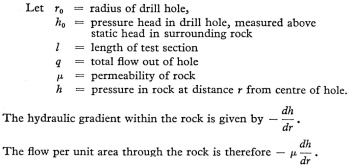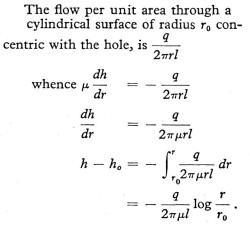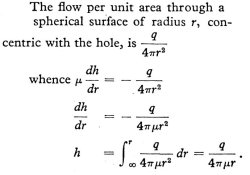DIAMOND DRILLING FOR FOUNDATION EXPLORATION-Moye
Acknowledgments.
This paper is given with the approval of the Snowy Mountains Hydro-electric Authority. The views expressed are those of the author and not necessarily of the Authority.
References.
- Moye, D. G.—Engineering Geology for the Snowy Mountains Scheme. Jour. I.E.Aust., Vol. 27, No. 10-11, Oct.–Nov., 1955, pp. 287–98.
- Talobre, J.—La Mecanique des Roches. Paris, Dunod, 1957.
APPENDIX.
Talobre (Ref. 2, p. 154) states as an empirical rule that ground is sufficiently impervious for dam foundations or a pressure tunnel, if the rate of water loss from a drill hole 46 to 74 mm. in diameter does not exceed 1 litre/min./m. of hole at a pressure of 10 atm., maintained for 10 min. This rate of loss of 1 litre is defined as one Lugeon Unit. (This is equivalent to 0.067 gal./min./ft. at a pressure of 145 lb./sq. in.) The tests should be carried out on sections 2 m. long.
In the following analysis by M. A. Chapple, the rock is assumed to be homogeneous and isotropic with respect to its permeability and flow is assumed to be laminar.

If the length of the test section is large compared with the diameter of the hole, flow conditions in the vicinity of the hole are essentially two- dimensional.

At a distance from the hole which is great compared with the length of the test section, flow conditions are essentially spherically symmetrical in three dimensions.

